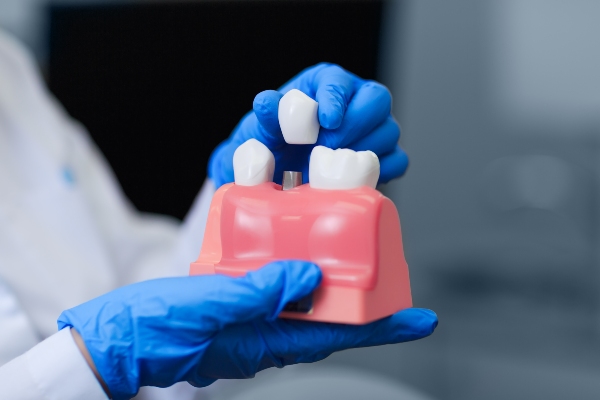A Periodontist Describes Common Signs of Gum Disease

Patients who seek treatment from a Periodontist for gum disease are often surprised that the condition does not always cause pain. Although gum disease is may be painless, other signs can prompt treatment to prevent tooth loss.
What is gum disease?
Gum disease, or periodontitis, starts with a buildup of bacteria-filled plaque along the gum line that causes gingivitis. Gingivitis causes inflammation and bleeding of the gums, but it does not affect tooth stability and is reversible through proper oral hygiene. However, bacteria can reach below the gum line if left untreated, causing infection, which compromises the jawbone and tissues that support the teeth.
What are common signs of gum disease?
A periodontist can educate patients about how to identify gum disease that requires urgent treatment. Patients should not ignore the following signs, which are often painless and subtle.
Bleeding gums
Gums that occasionally bleed during brushing and flossing may result from overly rigorous home care, but chronic bleeding, even if slight, indicates gingivitis, the earliest form of gum disease. Fortunately, at this stage, it is possible to prevent periodontitis or advanced gum disease with better oral hygiene habits, including regular in-office dental cleanings.
Red and swollen gums
Overzealous brushing and flossing or using a hard-bristled toothbrush can cause red and swollen gums. Gum disease might be the culprit when the condition does not resolve following adjustments to oral care techniques.
Receding gums
Gum recession has many causes, including:
- Excessive force while chewing due to bite misalignment
- Extreme pressure from teeth grinding
- Aggressive brushing that wears away tooth enamel
- Tartar buildup at the gum line from tobacco use
Gum recession may also signify gum disease. For example, a bacterial infection can take hold of the gum line and wear away the gums. Gum recession may also indicate that bacteria are reaching and destabilizing the underlying tissue and jawbone, which might eventually lose the ability to support the teeth.
Changing bite and loose teeth
Changes to bite can affect eating and chewing. Patients who detect an awkward bite or whose teeth can not tolerate the force of chewing should consult with a periodontist for a gum disease assessment. Bite changes and loose teeth are common signs of bacterial destruction of the jaw bone, leaving it unable to support teeth adequately.
Bad breath
Although digestive issues and food choices often lead to bad breath, a consistent problem could signify an entrapment of food particles between the gums and the teeth. Without removing the particles through daily home care and in-office cleanings, bacterial pockets that produce a foul odor can quickly form.
Pus
The body produces pus to combat infections, and pus that oozes from between the teeth is a definitive sign of gum disease that requires urgent treatment. If the pus cannot drain, it will accumulate in a pocket that protrudes from the gum.
Conclusion
A periodontist can determine the appropriate treatment for gum disease to prevent tooth loss. Patients should be aware of common signs of gum disease to ensure early intervention while the condition is still reversible.
Request an appointment here: https://www.torreyhillsperio.com or call Torrey Hills Periodontal Group at (858) 925-1188 for an appointment in our San Diego office.
Check out what others are saying about our dental services on Yelp: Periodontist in San Diego, CA.
Recent Posts
People who are seeking healthy gums but are dealing with challenges with gingivitis can see an expert periodontist, a dental professional who has studied the structures that support the teeth. These include the gums, the jawbone itself, and the ligaments that help hold the teeth in place.Periodontists are trained dentists who focus their attention on…
Wondering what the difference is between a regular dental cleaning procedure and a scaling and root planing procedure? Keeping gum disease at bay is important for all dental patients. Periodontists are dental specialists who focus on preventing, diagnosing and treating gum disease.Thinking about your upcoming scaling and root planing procedure? Periodontists are dental specialists who…
Pinhole gum surgery is a painless, non-invasive way of reversing gum recession. It is a far better alternative than the traditional option: Gum graft surgery. While gum surgery often requires multiple sessions in the dentist’s chair, pinhole periodontal surgery only needs one. There are many other reasons to choose pinhole surgery over a gum graft.…
A socket preservation graft can help speed the healing process after a tooth extraction. However, it is important to take some steps to help aid the healing process. Keeping the area clean will help you avoid an infection. You will also want to limit your diet in the first several days. It is a good…


